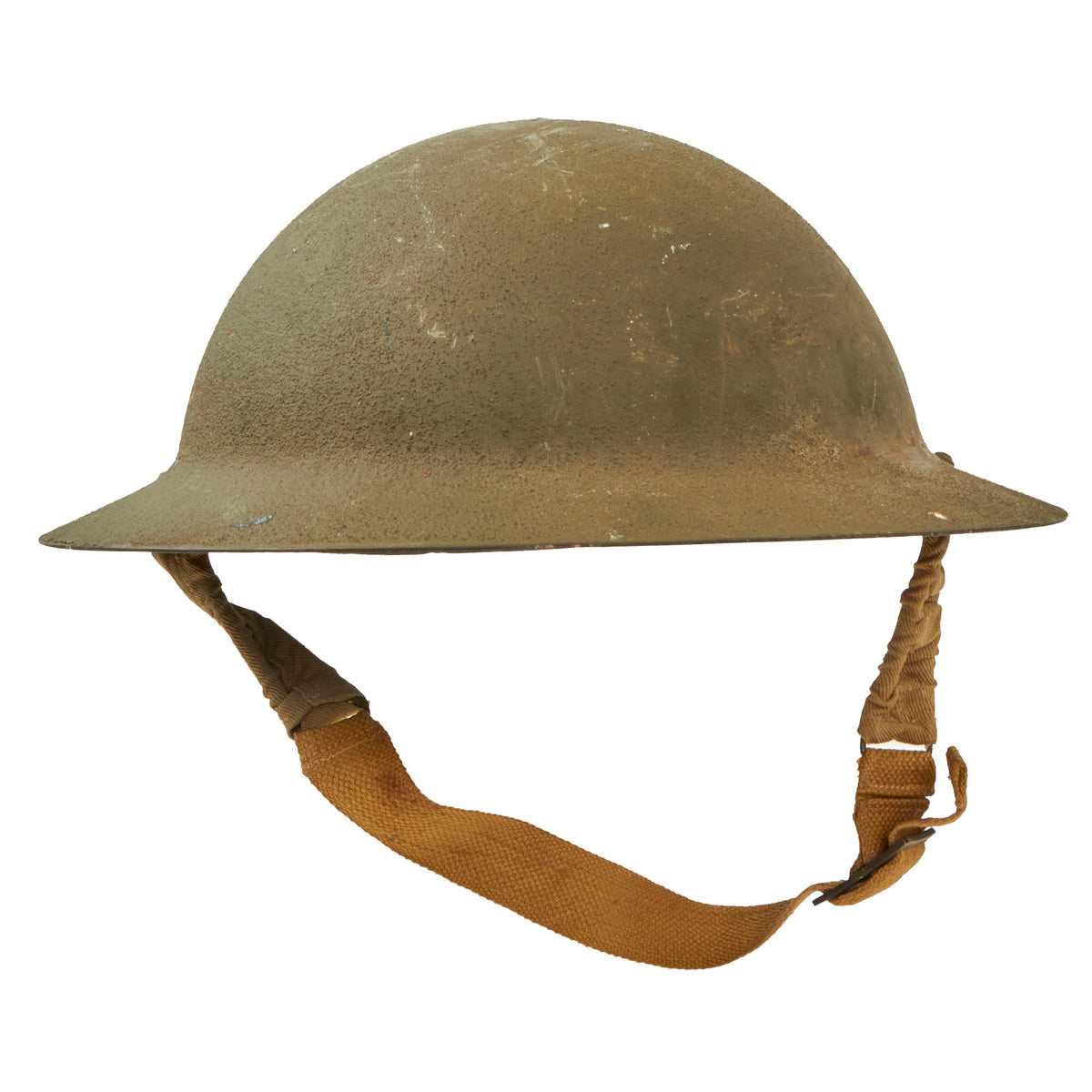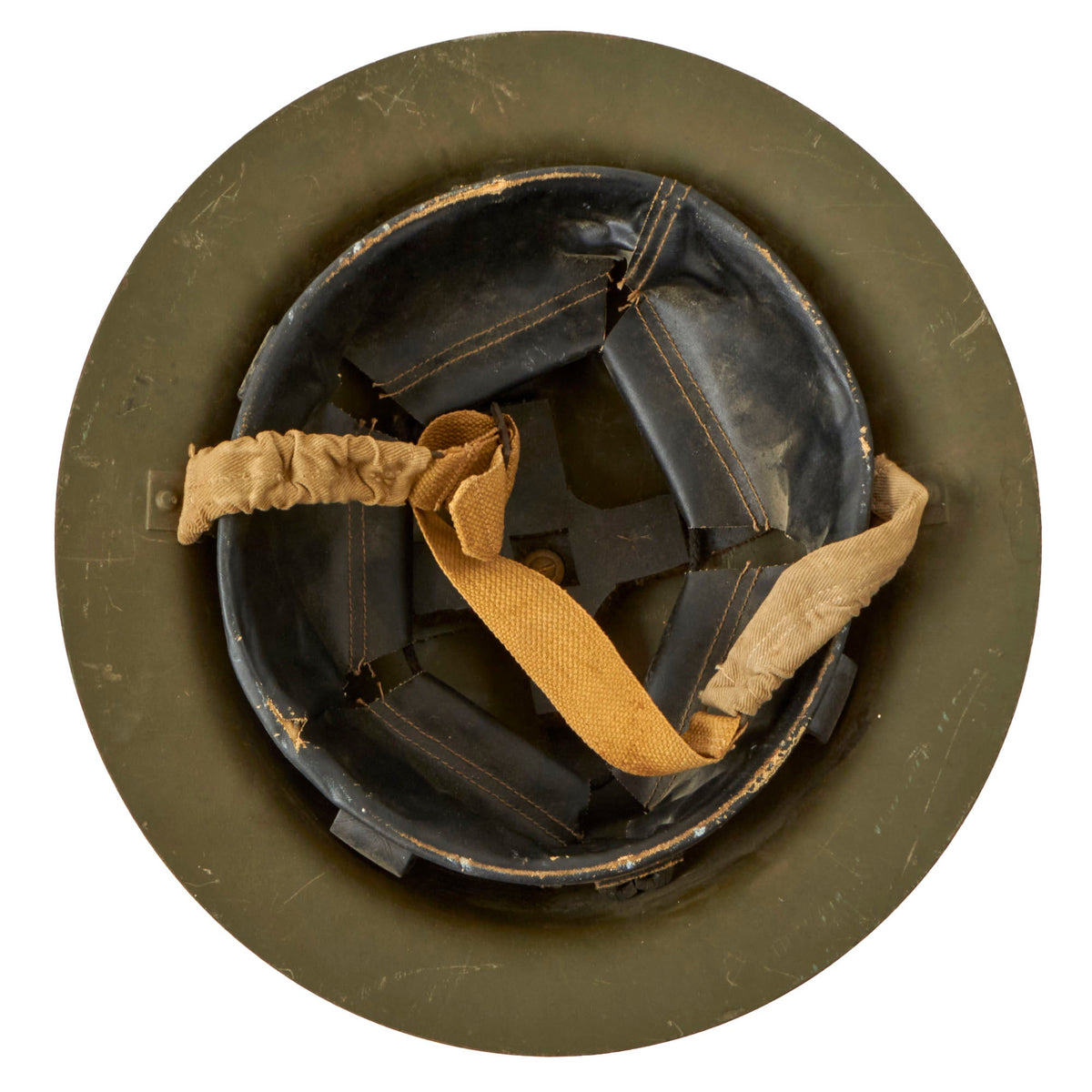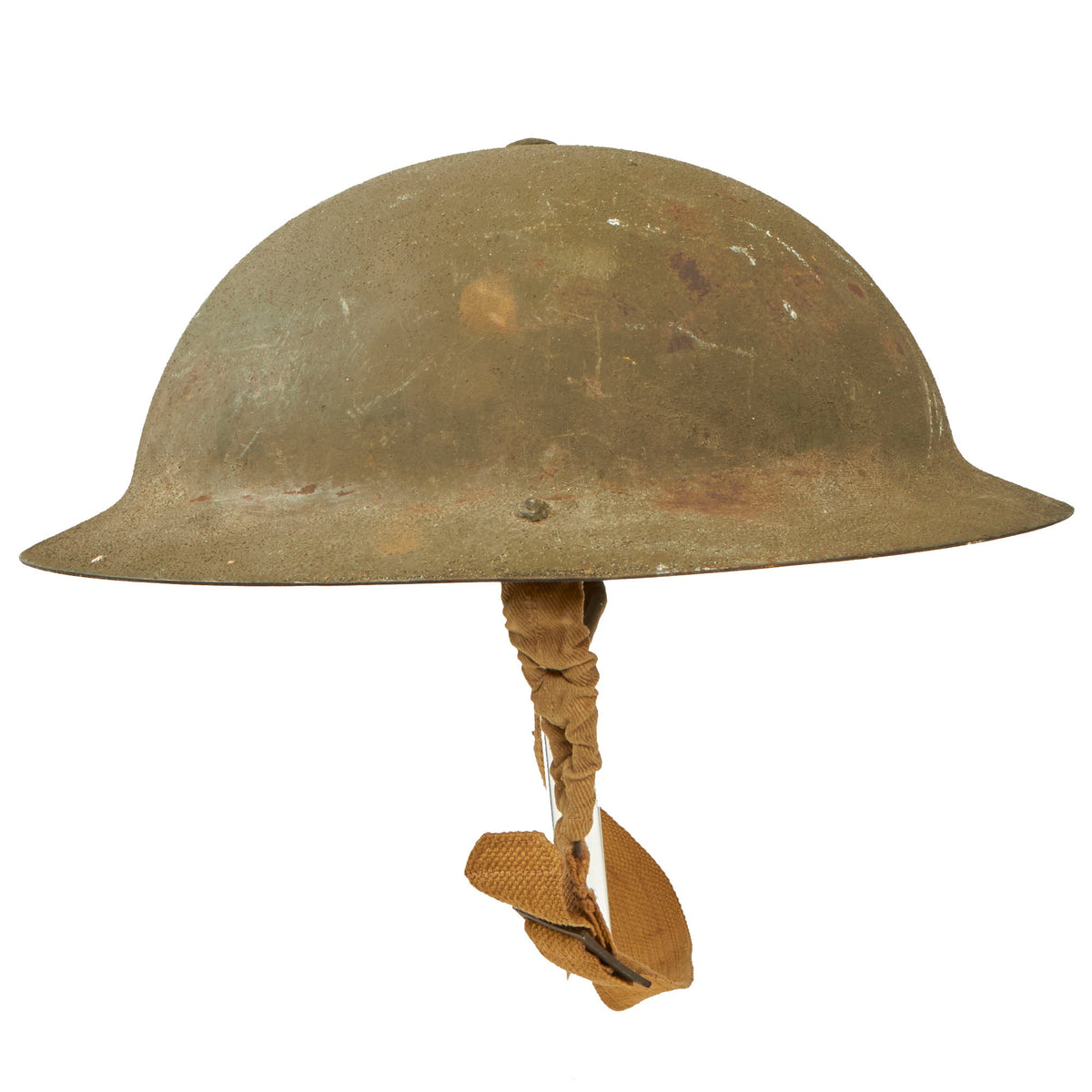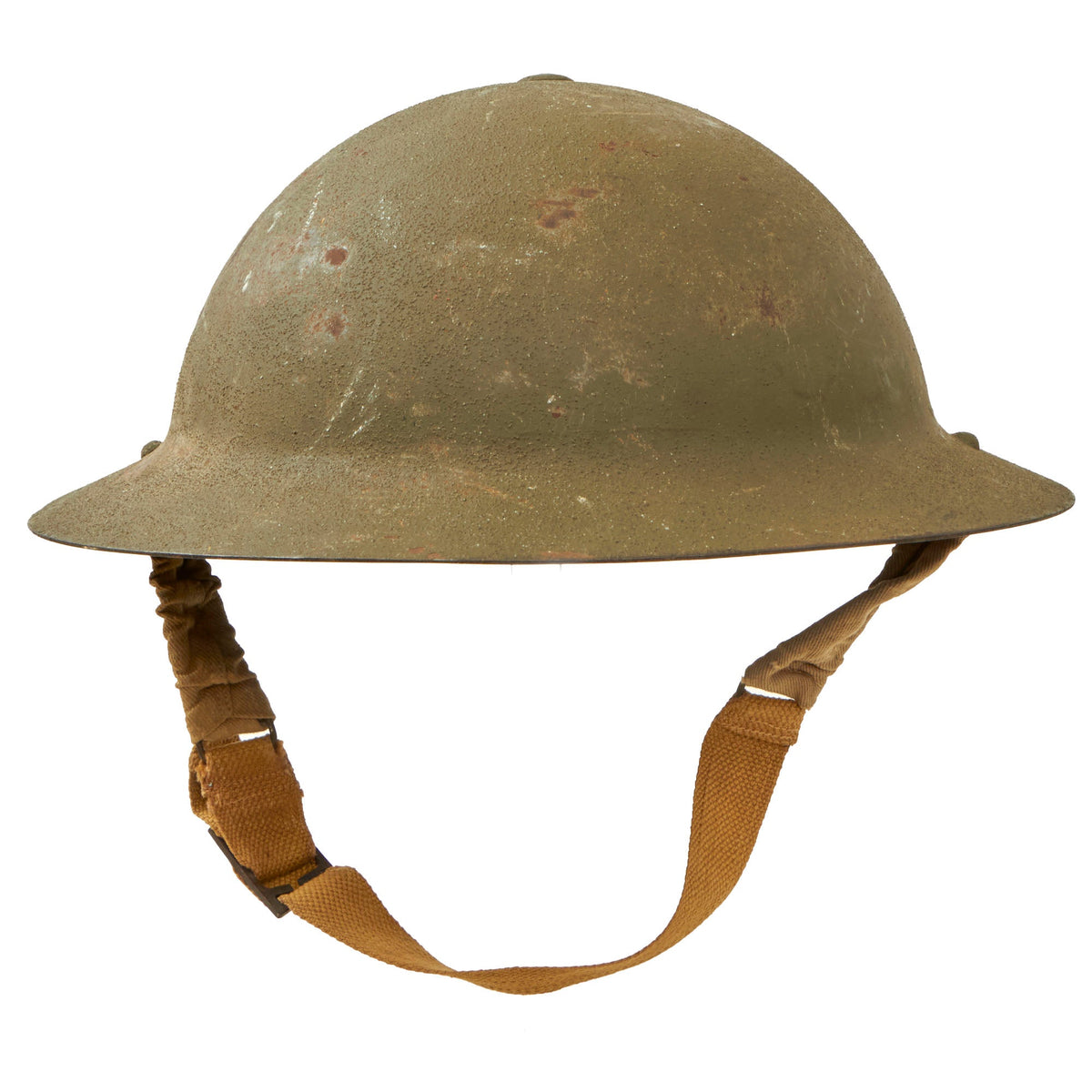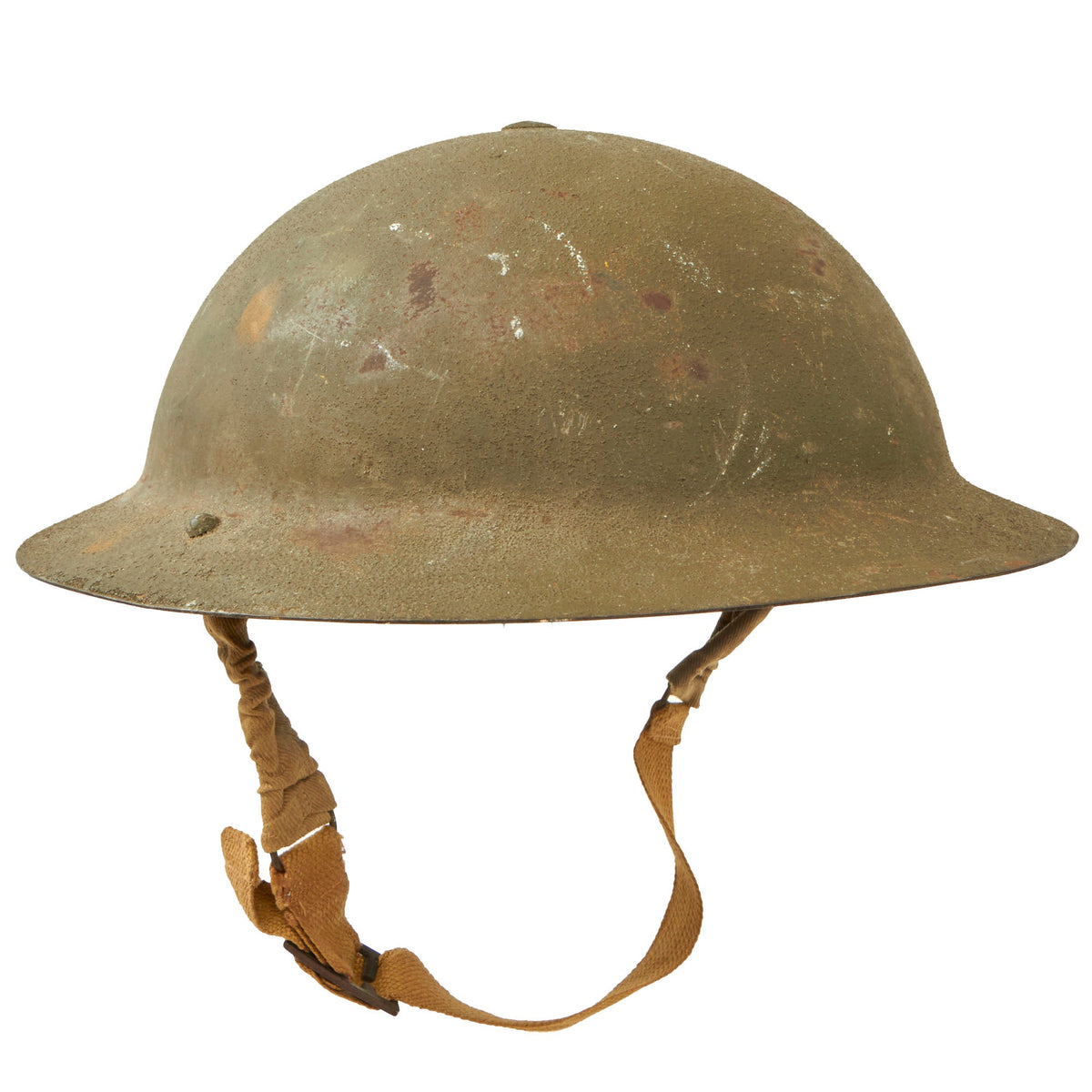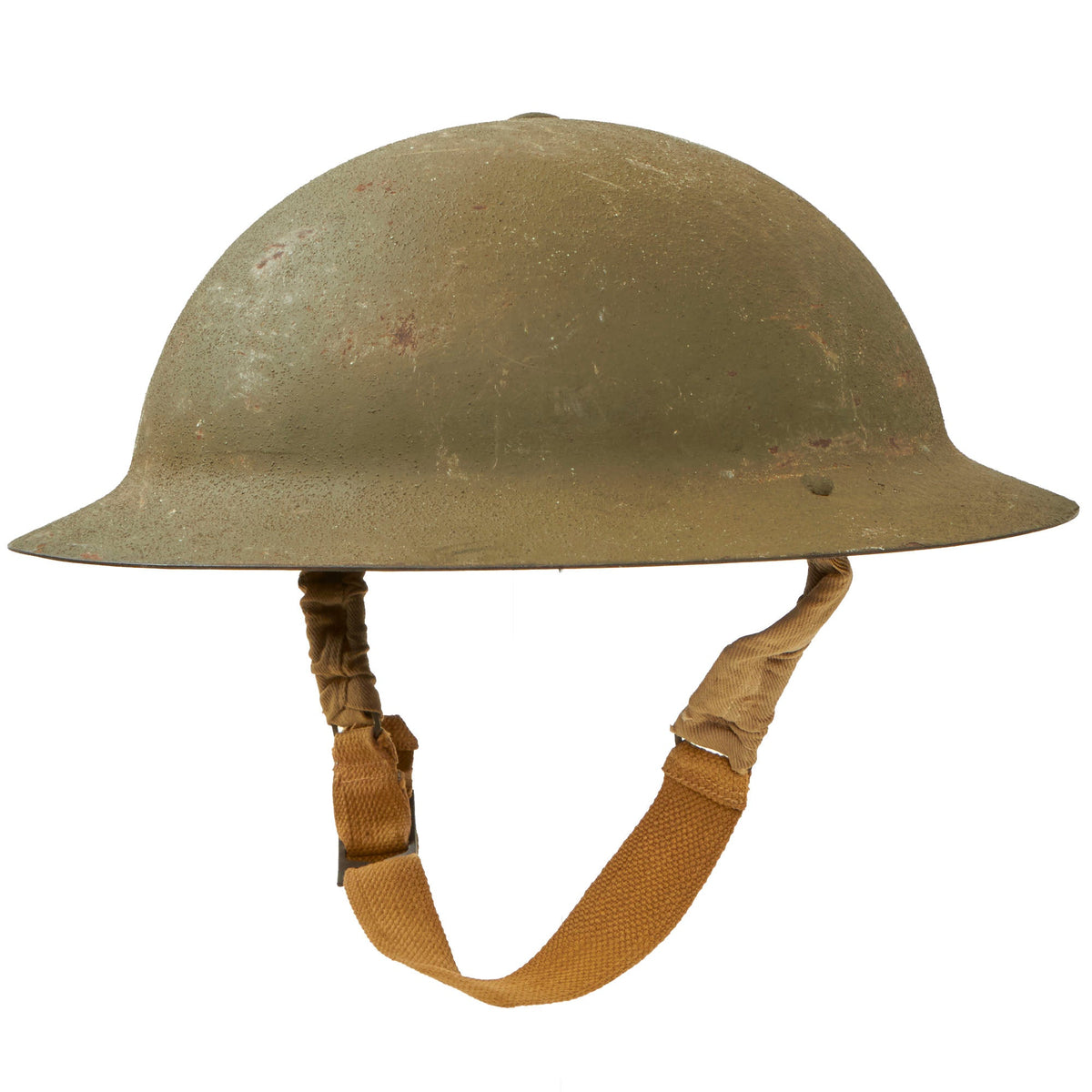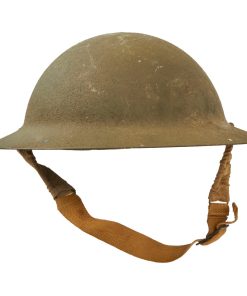Original Australian WWII Rimless Brodie MkII Steel Helmet with Liner Dated 1942 Original Items
$ 395,00 $ 118,50
Original Item: Only One Available. This is a great example of a genuine Australian Mark II steel helmet, complete with original liner and chinstrap. It’s clearly marked on both chinstrap bales MkIII 1942.
The chin strap bales in Australian helmets are where the date was located. This example is dated 1942 on both MkIII marked chin strap lugs. The paint appears to be in very good condition, and is the original sand textured Australian Army Khaki-Green No.3. Shell is overall in great shape with no major issues. There is no rim reinforcement, as there was no machinery in Australia available to bend the manganese steel strip. The original liner is also in excellent condition with the usual service wear present. The chinstrap is still present and in complete, serviceable condition.
A wonderful WWII 1942 dated Australian helmet that comes more than ready for display.
Australia entered World War II on 3 September 1939, following the government’s acceptance of the United Kingdom’s declaration of war on NSDAP Germany. Australia later entered into a state of war with other members of the Axis powers, including the Kingdom of Italy on 11 June 1940, and the Empire of Japan on 9 December 1941. By the end of the war, almost a million Australians had served in the armed forces, whose military units fought primarily in the European theatre, North African campaign, and the South West Pacific theatre. In addition, Australia came under direct attack for the first time in its post-colonial history. Its casualties from enemy action during the war were 27,073 killed and 23,477 wounded. Many more suffered from tropical disease, hunger, and harsh conditions in captivity; of the 21,467 Australian prisoners taken by the Japanese, only 14,000 survived.
Australian Army units were gradually withdrawn from the Mediterranean and Europe following the outbreak of war with Japan. However, Royal Australian Air Force and Royal Australian Navy units and personnel continued to take part in the war against Germany and Italy. From 1942 until early 1944, Australian forces played a key role in the Pacific War, making up the majority of Allied strength throughout much of the fighting in the South West Pacific theatre. While the military was largely relegated to subsidiary fronts from mid-1944, it continued offensive operations against the Japanese until the war ended.
World War II contributed to major changes in the nation’s economy, military and foreign policy. The war accelerated the process of industrialisation, led to the development of a larger peacetime military and began the process with which Australia shifted the focus of its foreign policy from Britain to the United States. The final effects of the war also contributed to the development of a more diverse and cosmopolitan Australian society.
History of the Brodie helmet:
The Brodie helmet, called Helmet, steel, Mark I helmet in Britain and the M1917 Helmet in the U.S., is a steel combat helmet designed and patented in 1915 by Englishman John Leopold Brodie. Colloquially, it was called the shrapnel helmet, Tommy helmet, Tin Hat, and in the United States the doughboy helmet. Worn by Australians during WW2 and sometimes known as ‘Panic Hat’. It was also known as the dishpan hat, tin pan hat, washbasin, battle bowler (when worn by officers), and Kelly helmet. The US version, the M1917, was copied from the British Mk 1 steel helmet of 1916. The German Army called it the Salatschüssel (salad bowl).
At about the same time, the British War Office had seen a similar need for steel helmets. The War Office Invention Department was ordered to evaluate the French design. They decided that it was not strong enough and too complex to be swiftly manufactured. British industry was not geared up to an all-out effort of war production in the early days of World War I, which also led to the shell shortage of 1915.
A design patented in 1915 by John L. Brodie of London offered advantages over the French design. It was constructed in one piece that could be pressed from a single thick sheet of steel, giving it added strength.
Brodie’s design resembled the medieval infantry kettle hat or chapel-de-fer, unlike the German Stahlhelm, which resembled the medieval sallet. The Brodie had a shallow circular crown with a wide brim around the edge, a leather liner and a leather chinstrap. The helmet’s “soup bowl” shape was designed to protect the wearer’s head and shoulders from Shrapnel shell projectiles bursting from above the trenches. The design allowed the use of relatively thick steel that could be formed in a single pressing while maintaining the helmet’s thickness. This made it more resistant to projectiles but it offered less protection to the lower head and neck than other helmets.
The original design (Type A) was made of mild steel with a brim 1.5-2 inches (38-51 mm) wide. The Type A was in production for just a few weeks before the specification was changed and the Type B was introduced in October 1915. The specification was altered at the suggestion of Sir Robert Hadfield to a harder steel with 12% manganese content, which became known as “Hadfield’s steel”, which was virtually impervious to shrapnel balls hitting from above. Ballistically this increased protection for the wearer by 10 percent. It could withstand a .45 caliber pistol bullet traveling at 600 feet (180 m) per second fired at a distance of 10 feet (3.0 m). It also had a narrower brim and a more domed crown.
The original paint scheme, suggested by Brodie, was a mottled light green, blue, and orange camouflage but they were also painted in green or blue-grey. That same month the first delivery of the helmets was made to British Army troops. Initially, there were far from enough helmets to equip every man, so they were designated as “trench stores”, to be kept in the front line and used by each unit that occupied the sector. It was not until the summer of 1916, when the first one million helmets had been produced, that they could be generally issued.
The Brodie helmet reduced casualties but was criticized by General Herbert Plumer on the grounds that it was too shallow and too light-reflective, its rim was too sharp, and its lining was too slippery. These criticisms were addressed in the Mark I model helmet of 1916, which had a separate folded rim, a two-part liner and matte khaki paint finished with sand, sawdust, or crushed cork to give a dull, non-reflective appearance. In 1917, the liner was modified to include a rubber cushion to make it more comfortable, although this was not adopted for the M1917. Towards the end of the war, helmets were often painted with unit insignia. These are often called “parade helmets” by collectors.
Fast Shipping with Professional Packaging
Thanks to our longstanding association with UPS FedEx DHL, and other major international carriers, we are able to provide a range of shipping options. Our warehouse staff is expertly trained and will wrap your products according to our exact and precise specifications. Prior to shipping, your goods will be thoroughly examined and securely secured. We ship to thousands clients each day across multiple countries. This shows how we're dedicated to be the largest retailer on the internet. Warehouses and distribution centres can be located throughout Europe as well as the USA.
Note: Orders with more than one item will be assigned a processing date depending on the item.
Before shipping before shipping, we'll conduct a thorough inspection of the items you have ordered. Today, the majority of orders will be delivered within 48 hours. The delivery time will be between 3-7 days.
Returns
The stock is dynamic and we cannot completely manage it because multiple stakeholders are involved, including our factory and warehouse. So the actual stock may alter at any time. It's possible that you may not receive your order once the order has been made.
Our policy is valid for a period of 30 days. If you don't receive the product within 30 days, we are not able to issue a refund or an exchange.
You can only return an item if it is unused and in the same state as the day you received it. You must have the item in its original packaging.
Related products
Uncategorized
Uncategorized
Band of Brothers ORIGINAL GERMAN WWII Le. F.H. 18 10.5cm ARTILLERY PIECE Original Items
Uncategorized
Angolan Rebel 1970s era 60mm Inert Display Mortar from Angolan Civil War Original Items
Uncategorized
Uncategorized
Uncategorized
Uncategorized
Uncategorized
Uncategorized
Uncategorized
Uncategorized
Uncategorized
Australian WWII Owen MK1 Machine Carbine SMG Custom Fabricated Replica with Sling Original Items
Uncategorized
Uncategorized
Uncategorized
Armoured Fighting Vehicles of the World: AFVs of World War One (Hardcover Book) New Made Items
Uncategorized
Uncategorized
Uncategorized
